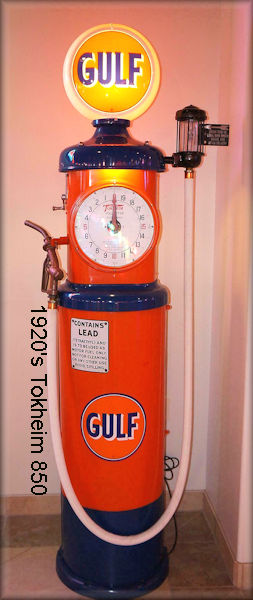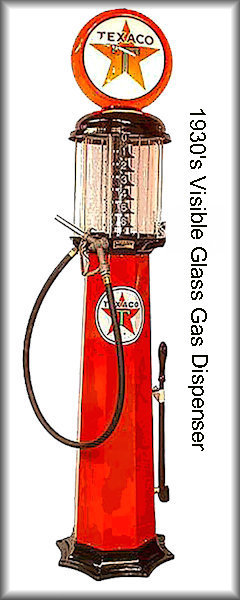



Mobile users:
For best results, view in Landscape mode.
In 1898, John Tokheim realized the dangers of above-ground
gasoline containers, so he developed an external storage and
pump system.
Tokheim’s 1898 pump system used a customized water pump which
allowed Tokheim to measure the amount of fuel dispensed.
In 1901, the first fuel dispenser and an underground container system
was patented by Norwegian John J. Tokheim.
Fuel retail industry giant OPW (a Dover company) acquired
Tokheim Company in 2016.
The system used underground holding tanks which allowed the
storage and distribution of gasoline to the surface
via a curbside or pony pump.

In 1939, the automatic shut-off valve was invented in Olean, New York
by Richard C. Corson.
At a loading dock at the Socony-Vacuum Oil Company,
Corson observed a worker filling a barrel with gasoline and thought
it inefficient.
The sound of a toilet flushing later gave him the idea for
a "butterfly float."
After developing a prototype with his assistant, Paul Wenke,
Corson gave the suggestion to the company who later
filed for a patent in his name.
The initial intent of the device was to allow a person to fill more
than one barrel (of gasoline) at the same time."
This mechanism eventually developed into the modern gasoline
pump cut-off valve.
The early gravity fed gas pumps with a clear cylinder were called
visible gas pumps.
They were about 8 - 10 feet tall.

Many early gasoline pumps had a calibrated visible glass cylinder
at the top of the pump, usually 5 or 10 gallons on top of
the pump, so you could see what you were getting, or if the gas was dirty
(a big problem at that time).
The desired quantity of fuel was pumped up into the cylinder as
indicated by the calibration.
Then the pumping was stopped and the gasoline was let out into
the customer's tank by gravity.
When metering pumps came into use, a small glass globe
with a turbine inside replaced the measuring cylinder, but assured
the customer that gasoline really was flowing into the tank.